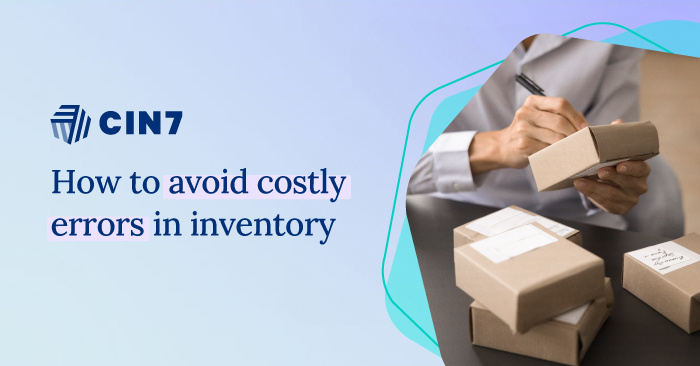
Accurate inventory accounting is an essential part of running a successful business. Among many other benefits, it ensures accurate financial statements, keeps costs in check, and supports regulatory compliance. Accurate inventory records can also guide smarter, more informed decisions on purchasing, production, and pricing.
However, like many other business processes, inventory accounting is susceptible to mistakes. This guide will walk you through some of the most common inventory accounting errors, their potential impact on your business, and most importantly, how to steer clear of them.
Inventory accounting 101: Debits and credits
Before diving into common inventory errors, let’s take a moment to understand the basics of inventory accounting.
Most businesses use a system called double-entry accounting to record their inventory transactions. This system is based on the principle that every financial transaction in a business affects at least two financial accounts in opposite ways.
When accounting for inventory, this means every inventory transaction must be recorded in two different accounts: one as a debit and the other as a credit to reflect the dual impact on the company’s financial records.
A transaction is recorded as debit when it leads to an increase in assets or a decrease in liabilities on your balance sheet. Conversely, it's recorded as a credit if it leads to an decrease in your assets or an increase in your liability.
For example, when a company purchases inventory, it records the transaction by debiting the “Inventory” account to reflect the increase in assets. At the same time, it credits the “Accounts Payable” or “Cash” account (depending on whether you made the purchase on credit or with cash) to account for the corresponding liability or reduction in cash.
Similarly, when goods are sold, the “Inventory” account is credited (decreased) and the “Cost of Goods Sold” (COGS) account is debited (increased) to reflect the expense incurred.
The total debits must equal the total credits for each inventory journal entry to ensure a balanced accounting ledger.
Example of an inventory journal entry
Let’s consider a scenario in which a manufacturing company purchases $10,000 worth of raw materials (on credit) from a supplier to produce goods. Here’s how the company might record this purchase on its accounting ledger.
|
Date |
Account Title |
Debit |
Credit |
|---|---|---|---|
|
|
Raw materials Inventory |
$5,000 |
|
|
|
Accounts Payable |
|
$5,000 |
Later, when the company pays the supplier, it will decrease (credit) the Cash Account and decrease (debit) the Accounts Payable account.
|
Date |
Account Title |
Debit |
Credit |
|
|
Accounts Payable |
$5,000 |
|
|
|
Cash |
|
$5,000 |
As the raw materials are used in production, additional journal entries will be made to move the cost from “Raw Materials Inventory” to “Work in Progress” (WIP), and eventually to “Finished Goods” and “Cost of Goods Sold.” This process makes sure inventory records accurately reflect the current state of the company’s assets at all times.
Common errors in inventory entries
Inventory accounting errors come in many shapes and forms. Let’s examine three of the most common sources of errors.
Incorrect inventory valuation
Incorrect inventory valuation happens when a business doesn’t properly assess the cost of its inventory and thus assigns a value that’s either too high or too low.
So what are the impacts? Well, overvaluing inventory inflates a company’s assets and profits, creating a misleading picture of its financial health. On the other hand, undervaluation causes understatement of assets and profits, which can lead to unfavorable financial analysis and decision-making.
There are several causes of incorrect inventory valuation, but the two primary ones are i) inconsistent or incorrect application of inventory valuation methods (such as First-In, First-Out (FIFO), Last-In, First-Out (LIFO), or the Weighted Average Cost method), and ii) failure to account for damaged or obsolete inventory.
Misclassifying inventory costs
This error happens when businesses incorrectly categorize their direct and indirect costs of production.
Direct costs are those you can directly trace to the production of specific goods or services — for example, raw materials and direct labor.
Indirect costs are those you cannot directly trace to specific products, but that are still critical for the overall functioning of business. Examples are rent, utilities, insurance and administrative salaries.
Improperly classifying these costs can lead to several financial inaccuracies:
- Inflated inventory values: If an indirect cost — like warehouse rent for instance — is incorrectly classified as a direct cost, the value of the inventory could be overstated. This misclassification results in higher reported inventory values on the balance sheet and potentially misleading gross profit margins.
- Undervalued inventory: Conversely, if direct costs — such as materials or labor directly associated with production — are not properly allocated to inventory, the value of inventory could be understated. This can reduce the reported net income and potentially affect pricing strategies and business decisions.
To avoid this error, establish clear guidelines and processes for distinguishing between direct and indirect costs. Regular reviews of cost classifications and proper training for accounting staff can also help ensure that all inventory costs are recorded correctly.
Data entry errors
These errors occur due to manual mistakes in entering data into accounting or inventory management systems. Common types of data entry errors include:
- Typographic errors: These are simple mistakes that include entering incorrect information, such as the wrong quantity, price, or item code. An example is entering a quantity of "10" instead of "100".
- Transposition errors: These occur when digits are accidentally swapped during data entry, such as entering "73" instead of "37."
- Duplicate entries: This is when you enter the same inventory receipt or shipment more than once.
- Omitted entries: This involves skipping items during stock-taking or failing to record a transaction entirely.
Consequences of inventory errors
Inventory errors can have significant repercussions on your business.
Inaccurate financial statements
Inventory errors can distort a business's reported profitability and financial health. For example, overvaluing inventory can lead to an understatement of the cost of goods sold and an overstatement of profit, giving a false impression of the company's financial performance. Conversely, undervaluing inventory can cause an overstatement of COGS and understated profits. These issues can damage investor confidence and stakeholder trust.
Tax implications
Incorrect inventory valuations can directly affect tax calculations. For example, overstated inventory values may result in higher taxable income, leading to overpayment of taxes. On the other hand, understated inventory values can cause underpayment of taxes, exposing the business to potential penalties, interest charges, or audits by tax authorities once discovered.
Legal issues
Inventory errors can, in some cases, result in legal consequences. For example, for publicly traded companies, inaccuracies in financial reporting due to inventory errors could lead to violations of securities laws. That could lead to penalties or fines from regulatory authorities like the Securities and Exchange Commission (SEC) once these violations come to light.
Such errors could also lead to lawsuits from shareholders or creditors who feel they were misled by inaccurate financial statements.
Impact of business decisions
Accurate inventory data is crucial for informed decision-making. Errors in inventory records can lead to misguided business strategies, such as incorrect pricing on products, poor budgeting, and ineffective inventory management practices. This can ultimately affect the company’s competitive position in the market as well as its long-term sustainability.
Best practices for avoiding inventory accounting errors
Regular reconciliation
Reconciliation is the process of comparing physical inventory counts with the inventory records in the accounting system to identify and resolve any discrepancies.
This process ensures that the inventory records reflect the actual stock on hand, which is essential for accurate financial reporting and effective inventory management. Frequent reconciliation helps detect issues such as inventory shrinkage, theft, or recording errors before they escalate into significant problems.
How often you should reconcile depends on several factors, such as the size and complexity of your inventory, the nature of your operations, and industry standards. Most businesses find that reconciling inventory monthly or quarterly is sufficient. Those with high-volume or fast-moving inventory may benefit from more frequent checks however, such as bi-weekly.
Use of technology
Leveraging technology is another powerful way to minimize errors and enhance accuracy in inventory accounting.
Advanced third-party inventory management software can automate repetitive tasks, such as recording transactions, updating stock levels, and generating reports, thus lowering the risk of human errors.
Additionally, inventory management software can provide real-time visibility into inventory levels, transactions, and stock movements. This capability allows businesses to monitor inventory continuously, identify discrepancies promptly. Real-time visibility also supports more accurate forecasting and inventory planning.
Many modern inventory management systems also integrate seamlessly with other business applications, such as accounting software and point-of-sale (POS) systems. This integration ensures consistent data flow across all business functions, enhancing overall accuracy and efficiency.
Staff training and education
Making sure your team members are well-versed in inventory accounting principles is another great way to maintain accuracy and avoid errors.
Training programs should cover fundamental concepts of inventory accounting, including the principles of double-entry bookkeeping, inventory valuation methods, and the correct handling of inventory-related costs. Additionally, you should educate your staff on the use of inventory management software and tools.
Ongoing education is also important as accounting standards and technology evolve. Regular updates and refresher courses can help staff stay current with new laws and regulations, industry best practices, and technological advancements.
Wrapping up: The role of Cin7 in inventory management and accounting
Tracking, managing, and valuing inventory changes, especially in large and multi-faceted businesses, is a complex and challenging activity.
Despite your best efforts, errors can happen — whether it’s a data entry slip-up, misclassified cost, or valuation mistake. But as we’ve seen, there are ways to reduce the likelihood and impact of these errors. Some of the most effective strategies are regular reconciliation, leveraging the right technology, and properly training your employees.
That said, the single best way to reduce the chances of inventory accounting errors is to partner with a reliable inventory management solution provider.
Cin7 Core is a leading inventory management solution that provides cutting-edge features to help you optimize and streamline your inventory processes. These features include:
- Real-time inventory tracking: Cin7 provides real-time visibility into your inventory levels across multiple locations.
- Purchase order management: Cin7 can help you manage your purchase orders, from creation to receipt.
- Warehouse management: Cin7 offers features to help you manage your warehouse operations, including picking, packing, and shipping.
- Integration with other systems: Cin7 integrates with a variety of other systems, including your accounting software, POS system, and e-commerce platform, ensuring seamless data exchange between them.
Schedule a demo today to see Cin7 in action and discover how it can transform your inventory management and accounting processes.
More from the blog
View All Posts
Five Reasons Your Accountant Appreciates You Using an Inventory Management System
Read More
Cost of Goods Sold (COGS) in a Perpetual Inventory System
Read More


